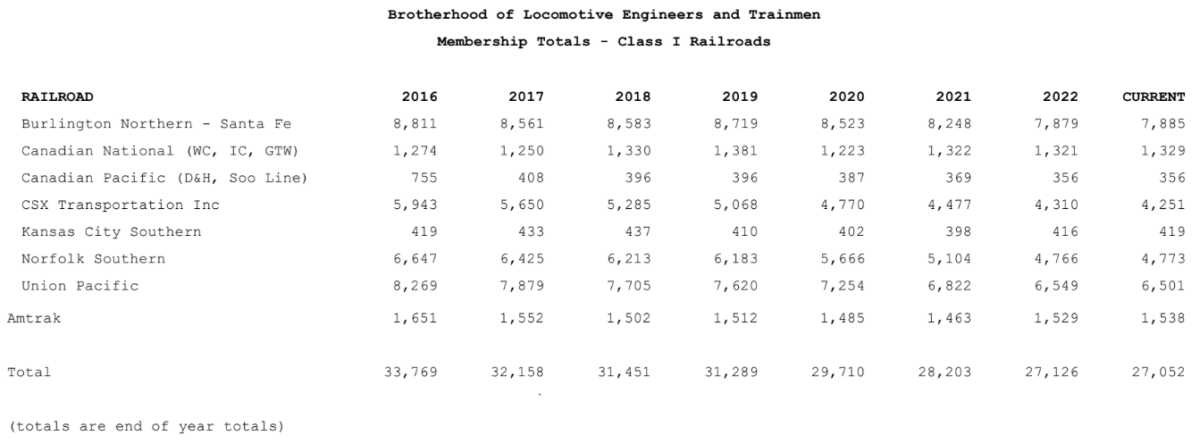Freight News:
Unions tell regulators that Class I railroads’ hiring efforts are misleading
The Class I railroads are still far under the employment levels needed to provide exceptional rail service, let alone grow network capacity, an attorney representing seven freight rail unions argued in a Monday filing to the Surface Transportation Board.
Although the railroads say employment levels have grown since last year, head count levels are well below 2019’s pre-pandemic levels if looking at the membership data of the different craft unions, according to attorney Richard S. Edelman on behalf of the unions.
“A complete picture of employment data shows that the Class I’s have only imperceptibly moved the needle on increasing their workforces,” Edelman wrote. “As the data supplied by the Unions demonstrate, the net employment numbers indicate weak or surface efforts to give the impression of attempts to increase employment, and suggest efforts to placate critics by giving the appearance of action. The statements of the executives and the public relations statements of the railroads are negligent at best, and intentionally misleading at worst.”
Edelman represents the following unions: the Brotherhood of Maintenance of Way – Employes Division, which is affiliated with the International Brotherhood of Teamsters; Brotherhood of Railroad Signalmen; International Association of Boilermakers; International Association of Machinists and Aerospace Workers District #19; International Association of Sheet Metal, Air, Rail and Transportation Workers – Mechanical Division; National Conference of Firemen and Oilers, 32BJ/SEIU; and the Transport Workers Union of America.
The purpose of the groups’ submission to STB was to update the board on whether changes in employment levels have led to improvements in rail service, and the filing was submitted in an ongoing proceeding meant to monitor the railroads’ service. During STB’s April 2022 public hearing on rail service, some witnesses, including Edelman, suggested that railroad head count reductions were the result of precision scheduled railroading, a method that sought to streamline operations.
According to employment data provided by the Class I railroads to STB, total head count within the U.S. operations of the Class I railroads in April was the highest it has been since May 2020, the start of the COVID-19 pandemic.
April’s headcount was 121,391 employees, up from 115,510 people in April 2022 and slightly under a five-year average of about 124,208 people, according to STB data.

But membership data from the various craft unions, as well as data provided by the Labor Bureau Inc., a labor economics and union finance consulting firm, better reflect nuances in recent employment trends, the unions via Edelman argued, saying that is because the STB data gets reported by department and not by craft.
While STB’s employment data shows increases in head count levels, the unions’ data shows that the growth rate persists to be uneven among the crafts. As a result, the labor shortages prevent the rail network from fully recovering, the unions argued.
STB’s employment data also excludes the rate of attrition at the railroads, which can also contribute to the unions’ perception that labor shortages are still ongoing, Edelman said.


In addition to head count data, the unions’ filing also includes documents detailing instances in which union members working for individual railroads determined that track or infrastructure wasn’t being adequately maintained.
The unions via Edelman also pointed to other transportation providers, such as Amtrak and the airline industry, arguing that they have been able to boost their ranks to exceed pre-pandemic levels.
“That Amtrak has been able to increase employment shows that the assertion that the railroad industry presents peculiar recruitment problems is just a false façade over a lack of desire to increase employment,” Edelman said.
A comparison with the airline industry is also noteworthy because that industry also faces similar working conditions such as irregular schedules and on-call work: “There is no reason railroads can’t fill positions while the airlines can, other than lack of will and refusal to respond to reduced supply as a market actor ought to react — by aggressive outreach and economic enticements,” Edelman said.
To bolster rail service, Edelman called upon STB to press Congress for help in proceeding with some rail shipper-prescribed remedies, such as clarifying what defines adequate rail service according to the railroads’ common carrier obligation, a federal guideline that binds the railroads to provide rail service.
Clarifying that definition may encourage the railroads to take more steps to bolster rail service — including filling the ranks of craft employees as a way to ensure efficient operations, according to Edelman.
The railroads should comply with STB’s efforts to bolster rail service because the board historically, as well as STB’s predecessor, the Interstate Commerce Commission, had granted the Class I railroads more market power by approving past mega-mergers under the expectation that those mergers would ultimately benefit shippers, said Edelman, arguing a point previously expressed by some shippers.
“Having reaped the benefits of Board approval of their creation, the railroads are in no position to object to the Board taking steps to ensure that they comply with their statutory obligations, and structure themselves (including as to staffing), to provide the public transportation benefits they represented would flow from Board approval of the transactions that created the mega- carriers and the industry that exists today,” Edelman said.
Subscribe to FreightWaves’ e-newsletters and get the latest insights on freight right in your inbox
Click here for more FreightWaves articles by Joanna Marsh.
Related links:
The post Unions tell regulators that Class I railroads’ hiring efforts are misleading appeared first on FreightWaves.
Source: freightwaves - Unions tell regulators that Class I railroads’ hiring efforts are misleading
Editor: Joanna Marsh